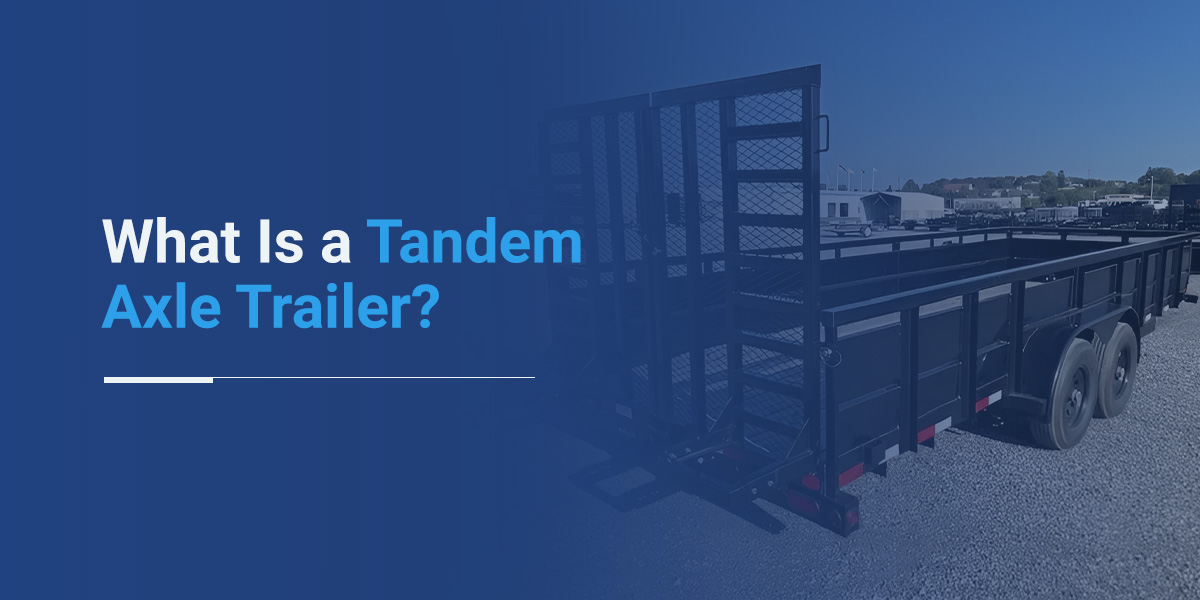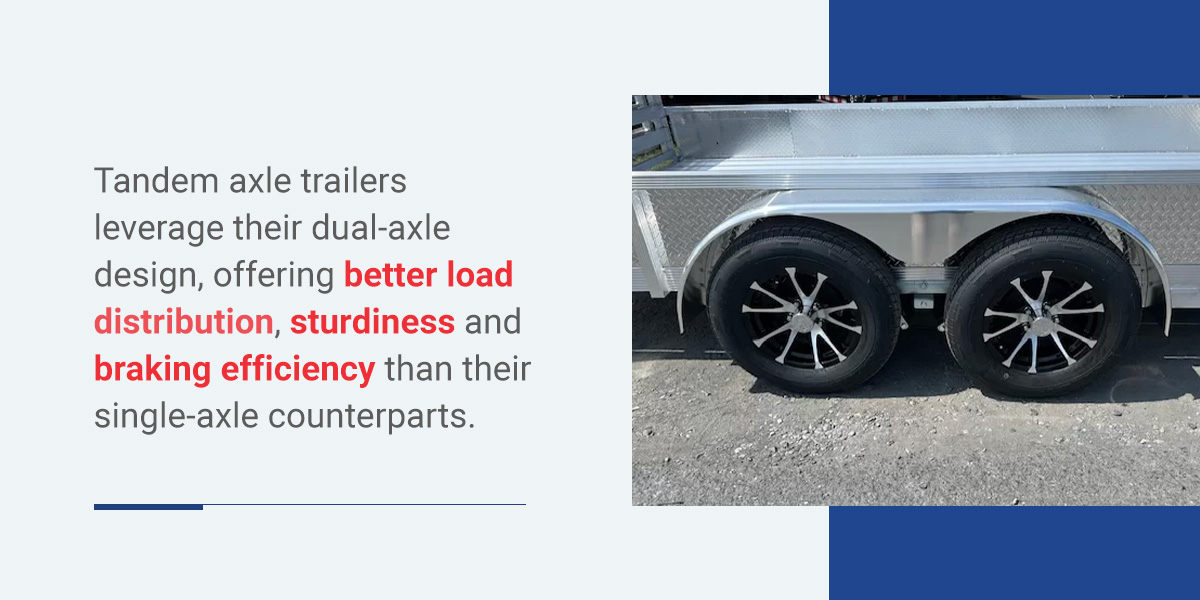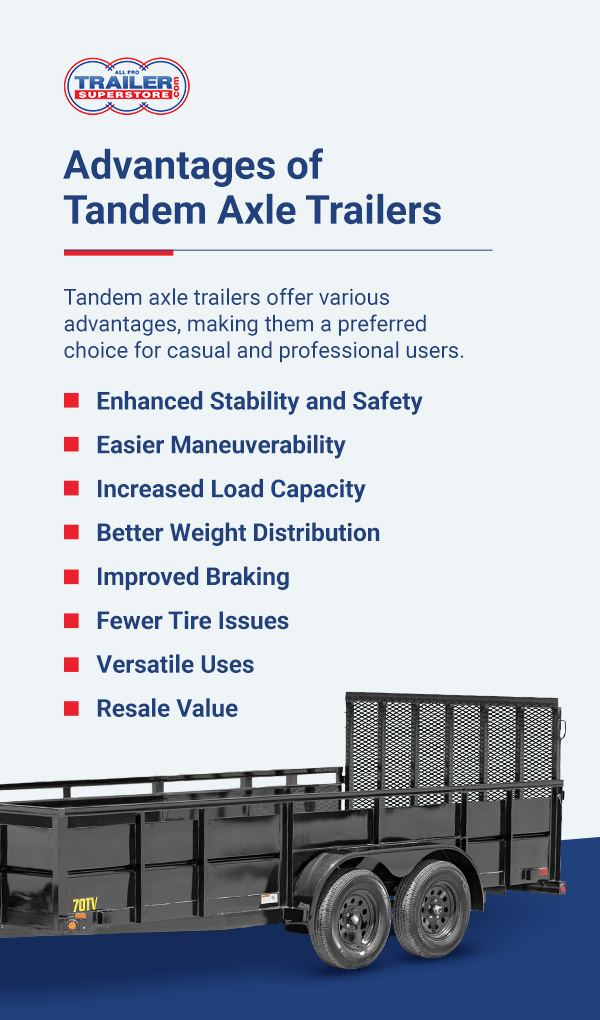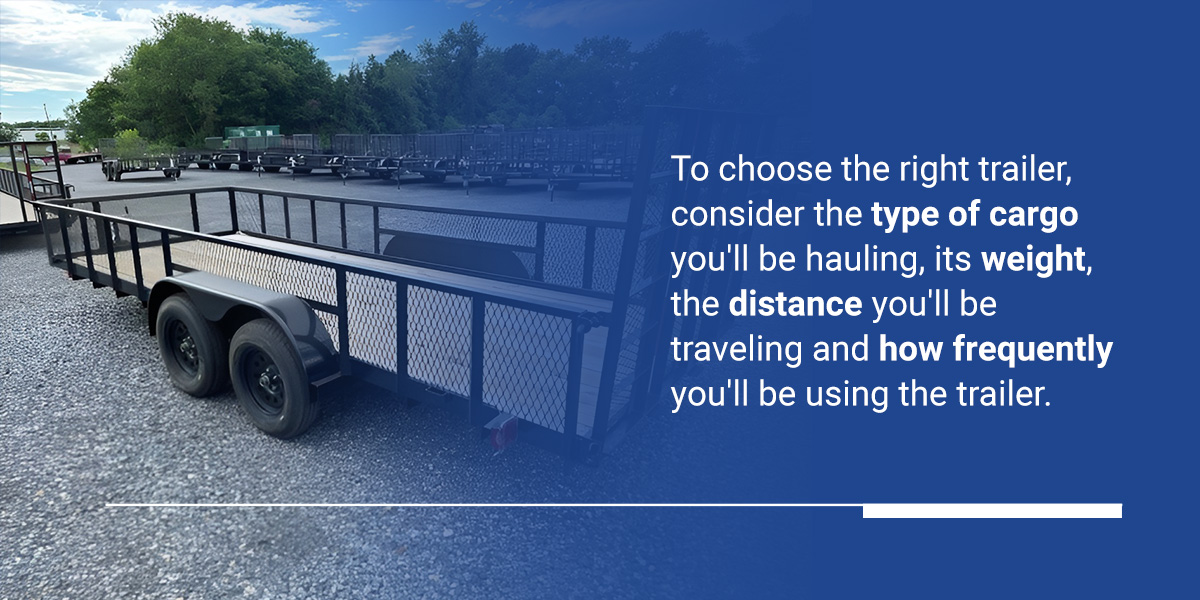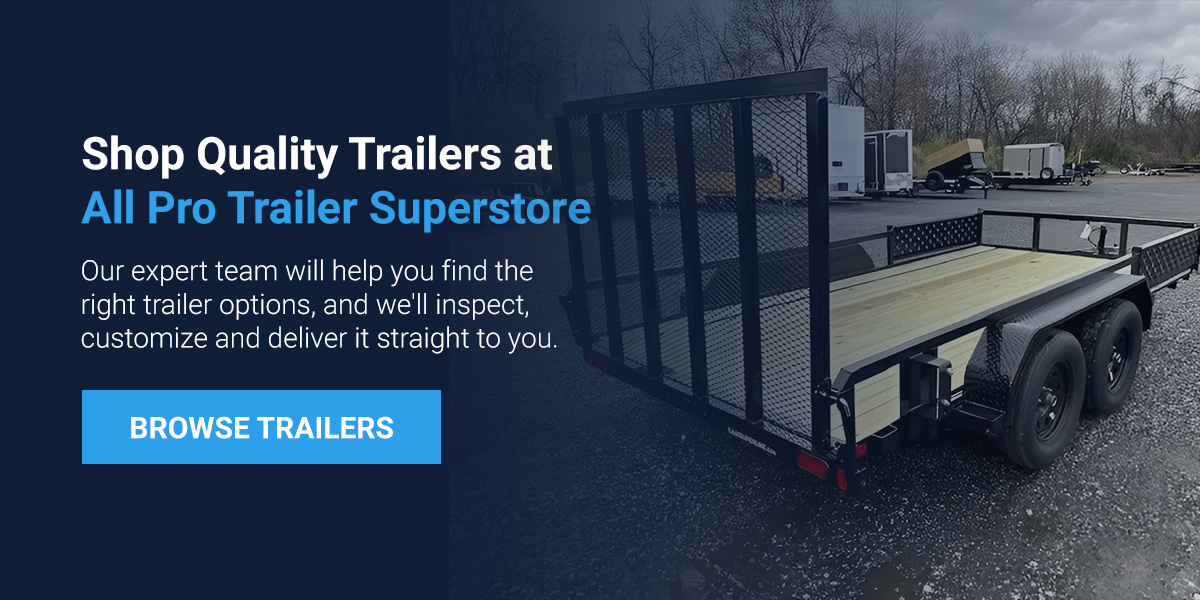What Is a Tandem Axle Trailer?
Aug 01, 2024Last Updated on August 1, 2024 by John Myers
Last Updated on August 1, 2024 by allprotrailersuperstore
Whether you need a trailer for work or leisure, a tandem axle trailer will help you get the job done right. These trailers consist of two sets of axles situated close to each other, designed to evenly distribute the weight of the cargo you’re hauling. Many people favor this type of trailer for its stability and load-bearing capabilities.
In this comprehensive guide, we’ll delve into how these trailers work, their applications and the advantages of owning one.
Table of Contents
- What Does Tandem Axle Mean?
- How Does a Tandem Axle Trailer Work?
- How to Jack Up a Tandem Axle Trailer
- Advantages of Tandem Axle Trailers
- Applications and Common Uses
- How to Choose a Tandem Axle Trailer
- Browse Tandem Axle Trailers Online
What Does Tandem Axle Mean?
Tandem refers to pairing two axles with wheels connected by a common suspension system — one in front of the other. For this reason, tandem axle trailers are also known as dual-axle or two-axle trailers. The configuration is especially useful for transporting heavy or oversized loads as it provides greater stability. Tandem axle trailers allow for a smoother ride and improved handling during transit than single-axel options.
How Does a Tandem Axle Trailer Work?
The tandem axle trailer works through the principle of load distribution. Each axle has its own set of wheels and tires, and they share the total weight of the trailer and its cargo. The size, type or number of axles often determines the amount of weight the trailer can handle and the vehicle’s load capacity.
The trailer’s main components include:
- Set of axles: Two axles allow for a more even weight distribution, offering better stability and minimizing wear on road surfaces due to reduced pressure. Spring and torsion axles are the most common types.
- Suspension system: The trailer’s suspension system connecting the axles plays a crucial role by absorbing shocks from road irregularities and keeping cargo stable. Some tandem axle trailers also feature equalizing suspension systems that adjust dynamically to uneven loads and road conditions, further enhancing stability and safety.
- Dual-break setup: With brakes on both axles, these trailers have advanced stopping power. The braking system offers better control, especially under heavy loads. Additionally, its dual-break setup allows for less brake wear and tear over time.
Tandem axle trailers leverage their dual-axle design, offering better load distribution, sturdiness and braking efficiency than their single-axle counterparts. These features make them invaluable tools for transporting large or heavy loads safely and efficiently.
How Much Does a Tandem Axle Trailer Weigh?
The weight of a tandem axle trailer will depend on its material, size and design features. An empty tandem axle trailer can weigh anywhere from 1,500 to 4,000 pounds. However, custom-built or specialized options may fall outside of this range. You must know the exact weight of your trailer to ensure compliance with vehicle towing capacities and road regulations.
How Much Can a Tandem Axle Trailer Carry?
The carrying capacity of a tandem axle trailer largely depends on its design and construction, though they’ll typically range from 7,000 to 12,000 pounds. When determining the weight your trailer can carry, consider the Gross Vehicle Weight Rating (GVWR) minus the weight of the empty trailer itself — also known as curb weight. Do not exceed this rating for safety and legal reasons.
How to Jack Up a Tandem Axle Trailer
Jacking up a tandem axle trailer requires careful steps:
- Collect the necessary tools: A regular bottle jack will not work since the larger tandem axle trailer weighs more than a single-axle model. Professionals typically recommend a tire ramp to jack up the trailer since it’s efficient and offers enough space to work without putting too much pressure on it. Also, gather a lug wrench, breaker bar, tire pressure gauge, socket and spare tire.
- Park the trailer on level ground: A smooth, level surface will ensure your trailer does not slide off the ramp. You might park it in a garage or parking lot to avoid traffic issues while working on it.
- Put your ramp in the correct position: Chock the trailer wheels opposite the side you’re lifting. This gives you a workable space. For example, if you were changing the front right tire of the dual axle, you’d position the ramp at the rear of the left back tire, with the low part of the ramp in the center of that rear tire.
- Elevate the trailer carefully: Place the jack under a solid frame area or designated lift point between the axles. Raise the trailer slowly until both tires are off the ground.
- Change the tire: Lift the trailer and remove the flat tire’s lug nuts. Replace it with a spare tire and tighten the lug nuts until they revolve. Slowly drive or back the trailer off the low end of the ramp.
To make the process as safe and smooth as possible, bring a person to help guide you. Be on the lookout for your surroundings, ensuring where you are working is secure.
Advantages of Tandem Axle Trailers
Tandem axle trailers offer various advantages, making them a preferred choice for casual and professional users. Here are some of the key benefits:
Enhanced Stability and Safety
With its additional axle design, these trailers offer better stability, especially at high speeds, reducing the risk of swaying and offering a smoother ride. With four tires on the ground and an enhanced suspension system, the trailer is safer for you and your passengers, providing better traction on slippery roads and even in the roughest weather conditions. Some people add sway control units to increase steadiness in windy areas and to protect cargo from excessive movement.
Easier Maneuverability
Tandem-axle trailers offer better maneuverability than single-axle trailers. Once you’re accustomed to the trailer’s size, navigating turns is much smoother with two axles. Their stability makes them easier to control on highways, with their wider turning radius reducing sway and offering swift transitions when turning. You’ll also have an easier time traversing uneven terrain, as the multiple axles provide better weight distribution, leading to improved traveling over bumps and dips.
Increased Load Capacity
Tandem axle trailers are designed to handle heavier loads than other trailers, making them ideal for hauling larger and bulkier items.
The increased weight capacity makes tandem axle trailers a good fit for commercial hauling, heavy equipment transport and extensive travel when carrying heavier cargo.
Better Weight Distribution
With two axles, tandem axle trailers spread weight more effectively over a larger area, ensuring a more balanced load. Even weight distribution places less stress on road surfaces, reducing road wear and minimizing the impact on the trailer’s tires and suspension components.
Better weight distribution can lead to lower maintenance costs and extended service life.
Improved Braking
Tandem axle trailers typically feature brakes on both axles, leading to superior stopping power, which is critical when transporting heavy loads. Improved braking also contributes to safety by reducing stopping distances and offering greater control when slowing down.
Fewer Tire Issues
With four tires on the ground rather than two, you get an extra layer of security in case one tire fails. Dual-axle trailers are also easy to change in the case of a blowout.
While a flat or blowout can be hazardous for any vehicle, having multiple tires on each side offers redundancy that allows you to safely pull over and address the issue. You might not even feel the effect of one flat tire.
Versatile Uses
Tandem axle trailers are highly versatile, offering a more efficient towing experience and making them a valuable asset for commercial or recreational use. Various industries, from construction to retail, leverage these trailers for hauling everything from raw materials to bulky furniture to heavy equipment.
Individuals can also leverage tandem axle trailers for diverse hauling needs, like moving boxes to a new house or hauling gear for a weekend getaway.
Resale Value
Due to their durability and versatility, tandem axle trailers typically retain their value better than others. They can handle heavier loads and offer better stability, making them attractive to a broader range of potential buyers in both commercial and recreational markets.
Applications and Common Uses for Tandem Axle Trailers
Tandem axle trailers are used across various industries, from agriculture to construction to recreation. Common applications include:
Commercial Transport
Tandem axle trailers are ideal for businesses that transport large quantities of goods. Their higher weight limit makes them suitable for moving furniture, large appliances and equipment:
- Retail and delivery services: Tandem axle trailers help retail businesses move stock across locations. They might transport refrigerated goods, clothing or bulkier items.
- Moving services: These trailers are invaluable for professional moving companies, offering ample space and weight capacity for oversized household items like pianos and heavy furniture.
- Event catering and mobile kitchens: Event organizers and catering companies might use customized tandem axle trailers to move mobile kitchens or catering equipment to event sites.
Agricultural Use
Farmers often use tandem axle trailers to haul livestock, feed, equipment or harvested crops because they can handle rough terrain while keeping items secure. Agricultural uses for these trailers include:
- Irrigation equipment transport: Farmers might use tandem axle trailers to move irrigation systems, water tanks and other bulky equipment for crop maintenance.
- Livestock shows: Tandem axle trailers can also efficiently transport animals, fencing and feed to livestock shows or fairs.
- Specialized crop transportation: These trailers can also securely transport delicate crops that require gentle handling over uneven rural roads.
Automotive Hauling
Auto dealerships and car enthusiasts alike rely on tandem axle car haulers to transport vehicles safely. The dual axles offer better support for multiple vehicles or larger machinery. For example, racing teams might use these trailers to haul race cars, spare parts and tools to events while keeping the vehicle safe and secure. Vintage car collectors might use tandem axle trailers for additional protection when transporting vehicles to shows or auctions.
Recreational Activities
Tandem axle trailers are ideal for hauling all-terrain vehicles (ATVs), boats, camping equipment and other recreational items. They offer plenty of space and support for various outdoor adventure gear, such as:
- Mobile homes and tiny houses: Adventurers and travel enthusiasts might use these trailers to tow their tiny homes or mobile houses on road trips or use them as the foundation for their portable living spaces.
- Camping gear: Many campers use tandem axle trailers to haul tents, camping furniture, coolers, grills and other bulky equipment that wouldn’t fit in a regular vehicle. They might also use them to tow boats, kayaks or jet skis to lakes and coastal areas for vacations.
- Off-road vehicles: Off-road enthusiasts can use tandem axle trailers to haul dirt bikes, ATVs or utility task vehicles (UTVs) to trails or desert landscapes.
Construction Sites
Tandem axle trailers are essential on construction sites. They allow workers to move heavy equipment such as bulldozers, excavators and building materials from one site to another. For example, you might use them to deliver bulk materials like gravel, concrete blocks or sand directly to a construction site. Contractors also convert their trailers into mobile workshops with tools, workbenches and equipment for on-site repairs.
Landscaping Businesses
Landscaping companies use tandem axle trailers to haul lawnmowers, soil bags, tree trimmers and other landscaping materials. They can use them to safely deliver trees, large plants and shrubs to clients without damage. These trailers also secure heavy items like pavers or retaining wall blocks during transport for hardscaping projects.
How to Choose a Tandem Axle Trailer
To choose a tandem axle trailer for your tasks, consider the following:
- Cargo weight and hauling needs: To choose the right trailer, consider the type of cargo you’ll be hauling, its weight, the distance you’ll be traveling and how frequently you’ll be using the trailer. From here, you can choose the right size, type and carrying capacity. For example, bulkier items like heavy equipment or off-road vehicles may require a larger trailer, while a smaller one would be ideal for smaller cargo or infrequent hauling needs.
- Material and build quality: Based on your durability requirements and weight preferences, decide between a steel and aluminum frame. While a steel trailer may offer better durability at a lower price point, aluminum is lighter, easier to maintain and will perform well in the long run. Each material has advantages, so consider your specific needs, budget and intended use.
- Add-ons: Consider any trailer add-ons you might need, such as removable sides, tie-down points or ramps. Some trailer owners opt for powered lift gates as a motorized alternative to manual ramps, especially for heavier cargo. At the same time, you might invest in enclosure add-ons for weather protection and to keep items secure.
- New or used: While a new trailer will cost more upfront, buying new allows you to get the advanced or innovative features you desire. Used trailers are affordable and offer good value if well-maintained. Assess your budget, the trailer’s intended use and the long-term cost of ownership to make an informed decision.
Shop Quality Trailers at All Pro Trailer Superstore
Tandem axle trailers are essential vehicle components for many tasks and industries — commercial or recreational. All Pro Trailer Superstore is an award-winning dealer and a one-stop shop for all your trailer needs.
Our expert team will help you find the right trailer options, and we’ll inspect, customize and deliver it straight to you. We also offer financing and trade-ins and may offer to purchase your older trailer if you’re selling.
Our vast inventory ensures you can find a trailer that fits your requirements, application and budget. Browse our high-quality trailers or contact us to learn about our products and services.


